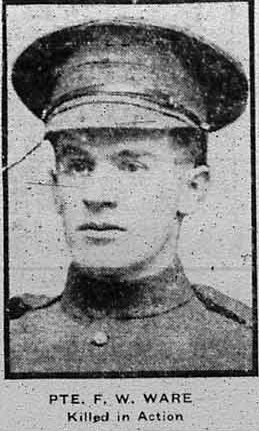Pte
Frederick William Ware
Informations sur naissance
|
Date de naissance: 02/10/1887 |
|
Lieu de naissance: Warrington, Lancashire, Angleterre, Royaume-Uni |
Informations générales
|
Profession: Ferblantier |
Informations service militaire
|
Pays: Canada |
|
Force armée: Canadian Expeditionary Force |
|
Rang: Private |
|
Numéro de service: 721189 |
|
Incorporation date: 11/12/1915 |
|
Incorporation nom de lieu: Winnipeg, Manitoba, Canada |
|
Unités: — Canadian Infantry, 43rd Bn. (Cameron Highlanders) (Dernière unité connue) |
Informations sur décès
|
Date de décès: 26/10/1917 |
|
Lieu de décès: Bellevue 's, Graventafel, Belgique |
|
Cause du décès: Killed in action (K.I.A.) |
|
Âge: 30 |
Mémorial
|
Ypres (Menin Gate) Memorial Panneau: 28 S |
Distinctions et médailles 2
|
British War Medal Médaille |
|
Victory Medal Médaille |
Points d'intérêt 3
| #1 | Lieu de naissance | ||
| #2 | Lieu d'enrôlement | ||
| #3 | Lieu du décès (approximatif) |
Mon histoire
Frederick William Ware was born in Warrington, Lancashire, England in 1887. He emigrated to Canada. In 1909 where he married Florence Mailman in Saint John, New Brunswick. Florence and Frederick had four children and the family ended up in Winnipeg, Manitoba, where Frederick worked as a tinsmith. In December 1915 Frederick, joined the Canadian Expeditionary Force. Nearly two years later, by the time of the Battle of Passchendaele, he served with the 43rd Canadian Infantry (Cameron Highlanders), part of the 9th Brigade, of the 3rd Canadian Division.
The 3rd Canadian Division attacked towards Passchendaele on the 26th with two Brigades. The 9th Brigade was on the right and moved forward with the 43rd Battalion, on the left, and the 58th Battalion, on the right; the 52nd Battalion was in support. Zero hour, was at 5.40 a.m. Initially the men made good progress, though the barrage was often too ragged. At dawn the advance of 58th Battalion was checked by heavy machinegun fire coming from German strongpoints at Laamkeek. The 58th retreated to their jump off line, as it was next to impossible to advance through the relentless machinegun fire.
The advance of the 43rd was more successful. At 8 a.m. the Highlanders reached the Bellevue crest, which was dominated by two large German pill-boxes. Half an hour later the men established positions in front of the blockhouses. But confusion rose in the ranks, and when the battalions on both the left and right flank were seen retreating, the Highlanders started pulling back. Only small parties held their ground on the ridge. The battalions were rallied at 10.30 a.m. and a new attack on Bellevue developed. By noon the line on the ridge had been restored. Now the Highlanders started clearing the Bellevue pill-Boxes. The strongpoints at Laamkeek also fell. The mopping up of the German defences took the remaining of the afternoon. In the meanwhile, the 52nd Battalion had taken over the attack. Throughout the rest of the day the men were subjected to heavy shellfire.
At 7.25 p.m. it was reported that the situation had normalized. The ridge was in Canadian hands and all positions had been consolidated. The 43rd was relieved at midnight of the 27th of October 1917. The battalion lost three officers and 36 men during their stay in the frontline. Sixty-six men went missing and ten officers and 234 other ranks were wounded. Frederick William Ware, 30, was killed during the attack on Bellevue. He has no known grave and is remembered on the Ypres Menin Gate Memorial.
The 3rd Canadian Division attacked towards Passchendaele on the 26th with two Brigades. The 9th Brigade was on the right and moved forward with the 43rd Battalion, on the left, and the 58th Battalion, on the right; the 52nd Battalion was in support. Zero hour, was at 5.40 a.m. Initially the men made good progress, though the barrage was often too ragged. At dawn the advance of 58th Battalion was checked by heavy machinegun fire coming from German strongpoints at Laamkeek. The 58th retreated to their jump off line, as it was next to impossible to advance through the relentless machinegun fire.
The advance of the 43rd was more successful. At 8 a.m. the Highlanders reached the Bellevue crest, which was dominated by two large German pill-boxes. Half an hour later the men established positions in front of the blockhouses. But confusion rose in the ranks, and when the battalions on both the left and right flank were seen retreating, the Highlanders started pulling back. Only small parties held their ground on the ridge. The battalions were rallied at 10.30 a.m. and a new attack on Bellevue developed. By noon the line on the ridge had been restored. Now the Highlanders started clearing the Bellevue pill-Boxes. The strongpoints at Laamkeek also fell. The mopping up of the German defences took the remaining of the afternoon. In the meanwhile, the 52nd Battalion had taken over the attack. Throughout the rest of the day the men were subjected to heavy shellfire.
At 7.25 p.m. it was reported that the situation had normalized. The ridge was in Canadian hands and all positions had been consolidated. The 43rd was relieved at midnight of the 27th of October 1917. The battalion lost three officers and 36 men during their stay in the frontline. Sixty-six men went missing and ten officers and 234 other ranks were wounded. Frederick William Ware, 30, was killed during the attack on Bellevue. He has no known grave and is remembered on the Ypres Menin Gate Memorial.
Sources 6
|
Ancestry https://www.ancestry.com/ Autre référence |
|
CWGC https://www.cwgc.org/find-war-dead/casualty/1596878/ware,-/ Sources utilisées |
|
Service Record http://www.bac-lac.gc.ca/eng/discover/military-heritage/first-world-war/personnel-records/Pages/search.aspx Sources utilisées |
|
The Long, Long Trail https://www.longlongtrail.co.uk/army/ Sources utilisées |
|
War Diary http://www.collectionscanada.gc.ca/lac-bac/search/arch Sources utilisées |
|
War Graves Registers http://www.bac-lac.gc.ca/eng/discover/mass-digitized-archives/commonwealth-war-graves-registers/pages/commonwealth-war-graves-registers.aspx Sources utilisées |
